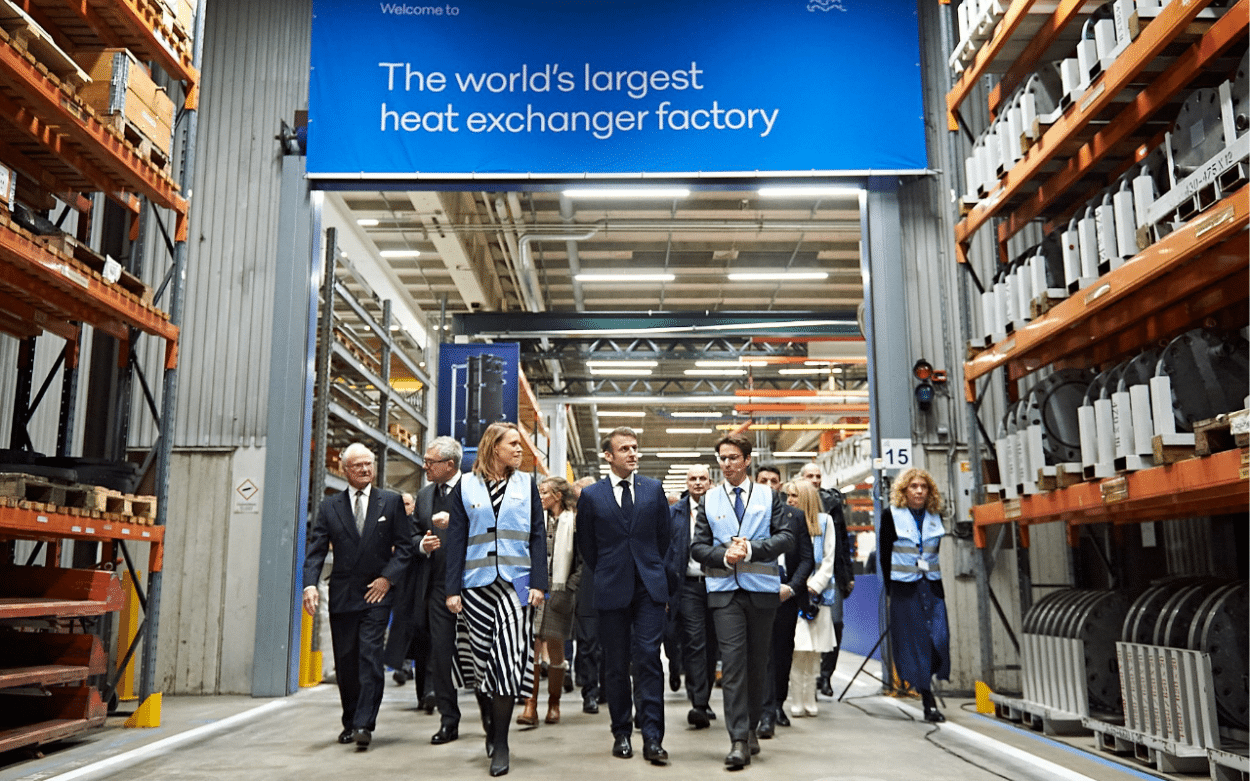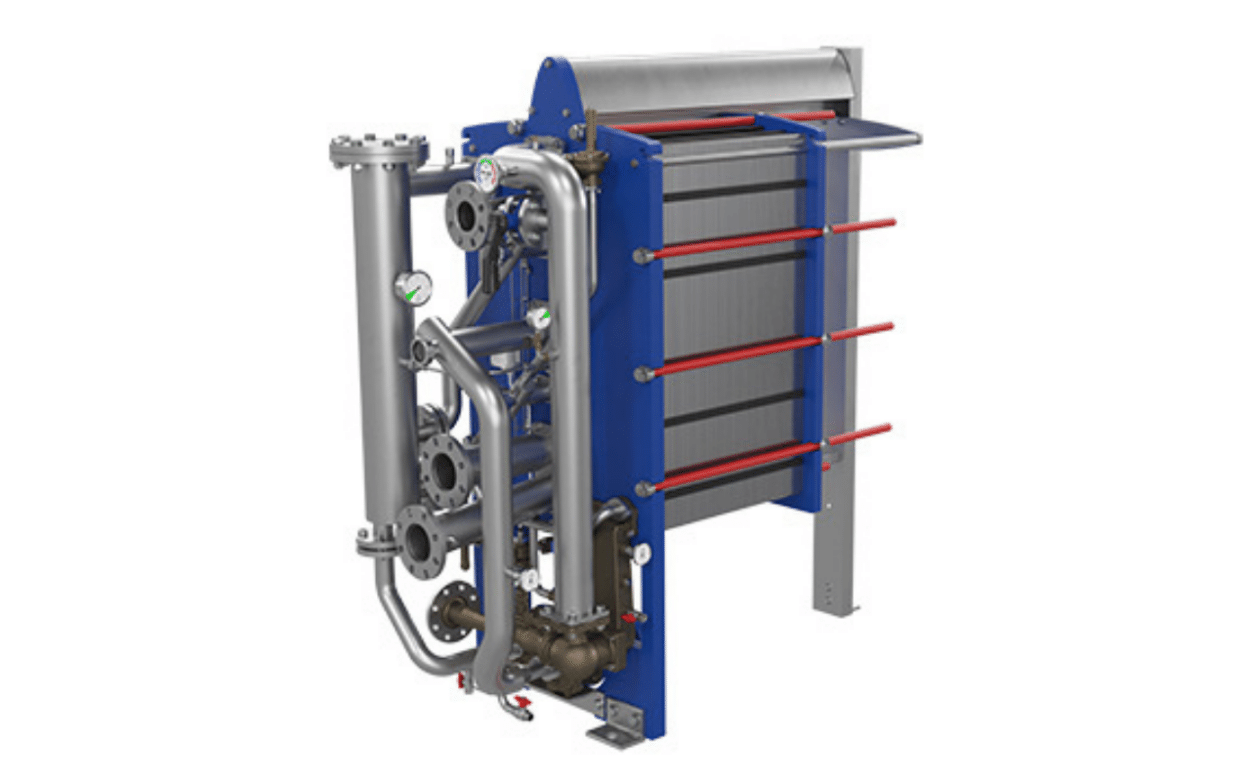Alfa Laval specializes in heat exchange, separation, and fluid transfer. Founded 140 years ago and based in southwestern Sweden, the company focuses on three strategic areas: water treatment for the food and pharma industries, energy (from energy production to distribution), and the maritime sector. The company indeed offers innovative solutions to support maritime industries in their energy transition away from fossil fuels toward decarbonized energy across all links in the chain. While the Euromaritime exhibition was held in Marseille last week, we spoke with Jean-Jérôme Semat, CEO of Alfa Laval France.

What are the challenges of energy transition for maritime transportation?
Jean-Jérôme Semat. “The roadmap is very clear. The international community aims to decarbonize the sector and achieve net-zero emissions for all maritime transportation.
In Europe, the situation is similar to that of individual vehicles. By 2035, vehicle manufacturing will cease, with policymakers opting for electric technology.
However, the maritime sector faces a different scenario, as policymakers have mandated achieving net-zero emissions without specifying a preferred technology. So, currently, each industry player is exploring various solutions, recognizing that there is no one-size-fits-all solution.”

How does Alfa Laval contribute to finding solutions?
Jean-Jérôme Semat. “Alfa Laval entered the marine sector in 1919. Our two flagship products are boilers and separators. Our boilers are based on natural circulation, while our separators handle oil and water separation. So, we maintain a traditional approach.
However, our challenge is that if we do not adapt our products in 10 or 20 years, we risk closing factories and discontinuing operations. That’s not our objective.
To address this, Alfa Laval has already taken proactive steps. Ten years ago, on January 25, 2014, we announced the establishment of a testing and R&D center in Aalborg, Denmark. Aalborg, the brand of our boilers, has been part of Alfa Laval for several decades.
We have created a full-scale testing and R&D platform, complete with an engine room similar to those found on ships, including exhaust and treatment systems. This setup allows us to conduct R&D akin to real-world conditions.
We do not work alone; we collaborate with shipowners. Shipowners are currently considering which comprehensive technological solutions to pursue, and we engage with them to find answers.”
RELATED ARTICLE

What solutions have you already found?
Jean-Jérôme Semat. “One solution that emerged quite quickly is LNG, which has several advantages for certain polluting projects. However, it’s not an ideal solution as it still involves gas, liquefied gas, which ultimately stems from fossil fuels. Nonetheless, it serves as a good transition.
We have already equipped many vessels, such as the Jacques Saadé, the flagship of CMA CGM, their largest container ship equipped with Alfa Laval dual-fuel boilers, enabling it to operate on LNG.
Another example we are exploring is what we call “power to mix” and “power to fuel.” Essentially, it involves using renewable energies and converting them into various media, such as ethanol, ammonia, or hydrogen, including green hydrogen. Some vessels are already being equipped, particularly with methanol.
Historically, our R&D was somewhat isolated, addressing market needs as we saw fit. However, today, we are striving to collaborate on R&D with various stakeholders in the industry, including engine manufacturers, as these new fuels have implications not only on engines but also on exhaust systems and associated components. This is evident when considering biofuels, where the characteristics vary depending on the feedstock used. Therefore, we examine not only the characteristics of our products but also their impact on engines and combustion quality, ensuring product longevity.
The goal is twofold: to validate technologies and fuels and to expedite their market introduction.
The second step is to scale up, which is significant. Today, despite having low-sulfur fuels, we still rely on a considerable quantity of traditional fuels. Therefore, the entire infrastructure needs to be addressed.
Speaking of infrastructure, ports also need to be equipped to meet demand since vessels typically travel from point A to point B.”

Where do you see the obstacles or challenges? On the side of shipowners or ports that are not yet equipped?
Jean-Jérôme Semat. “Today, everyone is working together to accelerate the transition. However, despite this, there are still factors that may hold us back somewhat. Significant investment capacity is required. Currently, regardless of the stakeholders in the market, some assets are operational. It’s necessary to dismantle these assets and rebuild them in a different form to meet new usage requirements. This is particularly true for shipowners and industrial players. Many shipowners have already opted for speed reduction.
Alfa Laval has announced an investment of 380 million euros, compared to our turnover of approximately 4 billion euros. This entails capacity increases in our factories and significant investments. We have tripled our R&D costs and are fully committed to decarbonization efforts. While we’re addressing scopes one and two for shipowners, the product we’ll deliver is steel, contributing to Scope three emissions reduction.”

You launched the first heat exchanger last year which is net zero.
Jean-Jérôme Semat. “We have quite a few heat exchangers in place installed on ships because ships have engines that generate heat and need to be cooled down, typically with seawater.
For example, we’ve manufactured steel using green hydrogen, 100% green hydrogen, in partnership with a Swedish steel producer, SSAB.
The first equipment has been sold, and it’s generating a lot of interest from data centers. There’s a growing momentum around this initiative.”




Can you tell us about OceanGlide, your innovation in fluidic air lubrication?
Jean-Jérôme Semat. “We acquired a patent, invested in it, and are now moving into the commercialization phase for this product.
It’s a product well-suited for existing boats. We’ll be installing bubble projection systems and fluidic oscillators underneath the flat hull of a vessel. These systems generate a uniform layer of micro air bubbles across the entire flat bottom surface of a ship. These bubble projections reduce friction on the water, thereby minimizing the power required. The system produces 240,000 bubbles per second per linear meter.
On average today, depending on sea conditions, we achieve around a 5% net power savings on a boat. This includes the additional power consumption from the compressors needed for operation. So, I’m specifically referring to net power. There are sea conditions where we can reach 10 to 12%, while in others, we may be at 3 to 4%, with the average being 5%.
We presented this at EuroMaritime. It’s quite mature, with around twenty vessels already equipped, and commercialization is now underway. The technology is proven and mature, having been validated. We’re also in the operational phase with some shipowners, and we have feedback from about twenty vessels.
What we’re commercializing is essentially the entire system. It’s installed under the boat’s hull. We’ll add a system beneath the boat’s hull, along with one or two compressors and blades inside the boat. Depending on the boat’s size, we’ll have a bubble system between one and three, creating a sort of bubble mattress beneath the vessel.”

Can you talk about AQUA Blue E2 and FCM Methanol, your two other innovations?
Jean-Jérôme Semat: “AQUA Blue freshwater generators are converting seawater into high-quality freshwater. With the AQUA Blue E2 model, ships can produce 20 to 130 cubic meters of freshwater per day using just one set of plates, all while consuming 50% less electrical energy compared to conventional boilers. Its benefits are important: it provides twice as much freshwater for the same amount of wasted heat or achieves the same freshwater output using approximately half the wasted heat. Ships can continue freshwater production during slow steaming, and the saved wasted heat can be diverted to power the E-PowerPack or other heat-consuming applications.
Our Fuel Conditioning Module Methanol (FCM Methanol) is designed to deliver methanol while adhering to the flow, pressure, temperature, and filtration parameters specified by the engine manufacturer. This adaptable technology can be customized for use with various types of engines and tanks. This system has been proven since 2015 and can supply methanol to both main and auxiliary marine engines, as well as boilers.”

There’s also OceanBird...
Jean-Jérôme Semat: “We’ve created a company called Oceanbird, where we implement sail systems on both new and existing vessels to offset a portion of fuel consumption. This ties into the other company we acquired, which specializes in maritime route calculations, as the wind detected by weather forecasts will propel these sails. It’s truly a comprehensive ecosystem.
In addition, we have an energy division. We’ve joined a consortium called Liquid Wind, which focuses on producing e-methanol from wind energy. The goal is to establish wind farms to store renewable energy and produce e-methanol for consumption, envisioning offshore wind farms powering ships, thus completing the cycle.
Our approach involves working across the entire value chain to address Scopes 1, 2, and 3, aiming to decarbonize the industry. Decarbonizing just one aspect is beneficial, but given the challenges we face, it’s imperative to address all fronts.
Currently, our energy relies heavily on fossil fuels, contributing significantly to CO2 emissions and climate change. Hence, Alfa Laval’s decision to achieve carbon neutrality for Scopes 1 and 2 by 2030, reduce Scope 3 emissions by 50%, and achieve net-zero Scope 3 emissions by 2050.
We recognize that we can’t bring products to market without ensuring our sustainability.”


Which technologies are the easiest to implement?
Jean-Jérôme Semat: “If I list them in order:
1. Biofuels: LNG is already in use. Now, it’s more a matter of availability. A traditional refinery produces millions of tons of conventional fuel, whereas a bio-refinery produces only tens of thousands of tons.
2. Ethanol combustion: We equipped the first ethanol-powered vessel in the 2010s, transporting ethanol. Now, it’s more about producing green ethanol. The technology is there today. However, scaling up will depend more on infrastructure, such as ports.
3. Ammonia: Ammonia has high toxicity, so there’s also a regulatory aspect. Typically, innovation outpaces regulations, but regulations must also evolve and adapt.
4. Hydrogen: We’re part of France Hydrogen and have made investments in France. We’ll inaugurate part of our factory on April 4, where we’ll produce heat exchangers in Grenoble dedicated to hydrogen. These heat exchangers are for hydrogen refueling stations. We also have another business unit responsible for producing the various plates on electrolyzers. The challenge is about scaling up hydrogen production.”

What insights do you draw from Euromaritime regarding the current market state?
Jean-Jérôme Semat: “The momentum is underway. Significant efforts are being made by all stakeholders across the entire value chain of the market, whether it’s in terms of port infrastructure or regulatory aspects. And we see this year after year.
Two years ago when we were at the show, we were on a panel discussing hydrogen. Today, when it comes to new fuels, we’re not just talking about possibilities; we’re discussing how to implement things and how to accelerate this implementation. So, we’re dealing with concrete actions. That’s what I take away from events like this.”










